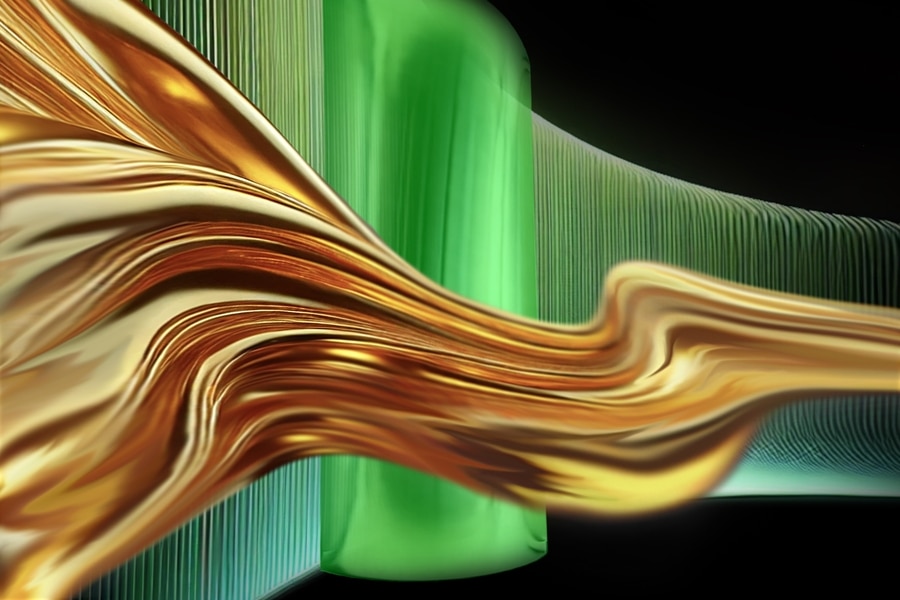
A rending of the quantum fluid (gold) flowing along a laser light wall (green) and moving around obstacles. (Image Credit: Sampson Wilcox/MIT)
MIT researchers recently observed edge states in a cloud of ultracold sodium atoms. They also captured images of atoms moving along a boundary without resistance, even if obstacles obstructed their path. This could lead to physicists manipulating electrons to flow frictionless in materials, enabling super-efficient, lossless transmission of energy and data.
Edge states were initially introduced to help explain the Quantum Hall effect. Scientists first observed this phenomenon in 1980 while conducting experiments in ultracold conditions and under a magnetic field. After applying a current through the material, electrons accumulate on one side in precise quantum portions instead of passing through the material.
Researchers explained this phenomenon by devising that edge states carried those currents. They suggest that a magnetic field can push electrons in an applied current to the materials’ edges. Here, the electrons flow and build up similarly to the initial observations. Instead of capturing the electrons in an edge state, the team attempted to replicate the physics in a larger, more observable system. They studied ultracold atoms’ behavior in a special setup mimicking the physics of electrons with a magnetic field present.
In this study, the researchers worked with a cloud of approximately one million sodium atoms that were shuttled into a laser-controlled trap before cooling them to nanokelvin temperatures. Afterward, they manipulated the system to make the atoms spin around the trap.
“The trap is trying to pull the atoms inward, but there’s centrifugal force that tries to pull them outward,” study co-author Richard Fletcher, assistant professor of physics at MIT, explains. “The two forces balance each other, so if you’re an atom, you think you’re living in a flat space, even though your world is spinning. There’s also a third force, the Coriolis effect, such that if they try to move in a line, they get deflected. So these massive atoms now behave as if they were electrons living in a magnetic field.”
The team then created an “edge” by introducing a ring of laser light that formed a circular wall around the spinning atoms. When the researchers captured images of the system, they saw the atoms flowing along the edge in one direction while encountering the ring of light. “You can imagine these are like marbles that you’ve spun up really fast in a bowl, and they just keep going around and around the rim of the bowl,” Martin Zwierlein, the Thomas A. Frank Professor of Physics, says. “There is no friction. There is no slowing down, and no atoms leaking or scattering into the rest of the system. There is just beautiful, coherent flow.”
The flow remained uninterrupted even if the atoms’ path became obstructed by a point of light along the edge of the laser ring. While approaching the obstacle, the atoms didn’t slow down or scatter. Instead, they flowed around it without resistance. “We intentionally send in this big, repulsive green blob, and the atoms should bounce off it,” Fletcher says. “But instead what you see is that they magically find their way around it, go back to the wall, and continue on their merry way.”
Their observations are similar to behaviors predicted to occur in electrons. “It’s a very clean realization of a very beautiful piece of physics, and we can directly demonstrate the importance and reality of this edge,” Fletcher says. “A natural direction is to now introduce more obstacles and interactions into the system, where things become more unclear as to what to expect.”
Have a story tip? Message me at: http://twitter.com/Cabe_Atwell

-

robogary
-
Cancel
-
Vote Up
0
Vote Down
-
-
Sign in to reply
-
More
-
Cancel
Comment-

robogary
-
Cancel
-
Vote Up
0
Vote Down
-
-
Sign in to reply
-
More
-
Cancel
Children